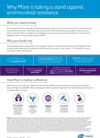About Anti-Infectives
What are anti-infectives?
Anti-infectives are medicines that work to prevent or treat infections, they include antibacterials, antivirals, antifungals and antiparasitic medications.
Why are anti-infectives so important?
Anti-infectives have revolutionized healthcare and are now critical in curing and even helping to prevent many kinds of infection. Thanks to anti-infectives, we can:1
- Treat minor infections and most often cure many serious infectious diseases, like pneumonia or tuberculosis
- Perform routine procedures and complex surgery, such as cesarean sections or joint replacements, which carry a risk of serious infection
- Give vital immuno-suppressive treatments, like chemotherapy, to people with cancer
Alarmingly, many anti-infectives are losing their effectiveness due to antimicrobial resistance (AMR).1
What causes infection?
Infectious diseases continue to be one of the biggest global public health concerns.1 But what causes infections in the first place?
References
- Review on Antimicrobial Resistance. Tackling drug-resistant infections globally: final report and recommendations. May 2016. Available at: https://amr-review.org/sites/default/files/160525_Final%20paper_with%20cover.pdf Last accessed March 2020.
- World Health Organisation. World Health Report: global health threats in the 21st century. 2007. Available at: http://www.who.int/whr/2007/overview/en/index1.html Last accessed March 2020.
- Review on Antimicrobial Resistance. Tackling a crisis for the health and wealth of nations. December 2014. Available at: https://amr-review.org/sites/default/files/AMR%20Review%20Paper%20-%20Tackling%20a%20crisis%20for%20the%20health%20and%20wealth%20of%20nations_1.pdf Last accessed March 2020.
- World Health Organization. WHO’s first global report on antibiotic resistance reveals serious, worldwide threat to public health. April 30 2014. Available at: http://www.who.int/mediacentre/news/releases/2014/amr-report/en Last accessed March 2020.
- Vasso S et al. Emerging issues in gram-negative bacterial resistance: an update for the practicing clinician. Mayo Clinic Proc. 2015;90:395-403.
- Schaalje J. Medical terminology: Gram positive vs. Gram negative bacteria. American College of Healthcare Sciences. April 12 2013. Available at: http://info.achs.edu/blog/bid/282924/Medical-Terminology-Gram-Positive-vs-Gram-Negative-Bacteria Last accessed March 2020.
- Cox R. Bacterial infections 101. OnHealth. May 11 2016. Available at: https://www.onhealth.com/content/1/bacterial_infections Last accessed March 2020.
- NHS Choices. Antifungal medicines overview. August 14 2017. Available at: https://www.nhs.uk/conditions/antifungal-medicines/ Last accessed March 2020.
- Centers for Disease Control and Prevention: Cancer Patients and Fungal Infections. Available at: https://www.cdc.gov/fungal/infections/cancer-patients.html Last accessed March 2020.
- Cox R. Viral infections: types, treatment and prevention. OnHealth. July 1 2016. Available at: https://www.onhealth.com/content/1/viral_infections Last accessed March 2020.
- Public Health England. Pre-school immunisations: a guide to vaccinations from two years old until starting primary school. Available at: https://assets.publishing.service.gov.uk/government/uploads/system/uploads/attachment_data/file/849563/Immunisations_for_Preschool_children_A5_booklet_Nov2019.pdf
- Centers for Disease Control and Prevention. Parasites. 27 September 2017. Available at: https://www.cdc.gov/parasites/about.html Last accessed March 2020.

